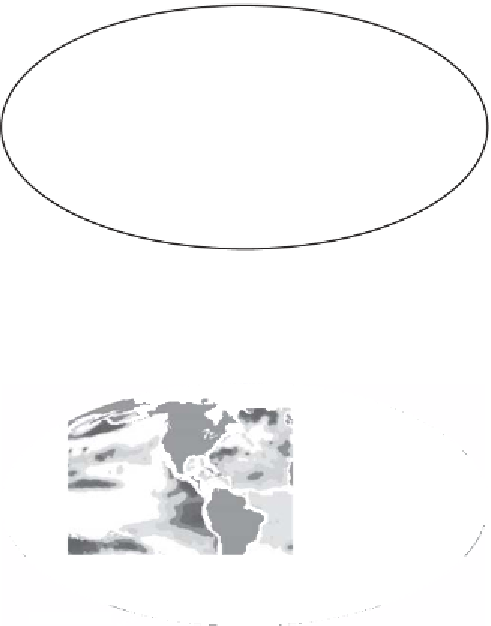Geoscience Reference
In-Depth Information
A Falling sea level
Ice-covered or out-of-range
Ice-covered or
out-of-range
Tide gauge record
0 mm yr
-1
-20
-10
B Rising sea level
Ice-covered or out-of-range
Ice-covered or
out-of-range
Tide gauge record
20 mm yr
-1
0
10
Changes in global sea level measured at coastal tide gauges between 1960 and 1979 (from Bryant, 1988) and from altimeters on the
TOPEX/POSEIDON satellite between January 1993 and December 1999: A) falls, B) rises (from Cazenave et al., 2002).
Fig. 8.10
15 mm yr
-1
; however, it is rising at similar rates along
the adjacent coastline. This is the signature of repeti-
tively strong ENSO and La Niña events. There are also
positive and negative changes at the boundary of the
Antarctic circumpolar current in the south Pacific
Ocean. Overall, global sea level has been rising
recently (Figure 8.10b). This is borne out in Figure 8.11,
which plots the average of all altimeter readings
between 1992 and 2002. Sea level is increasing at the
rate of 1.85 ± 0.42 mm yr
-1
, a value that is remarkably
similar to that determined using tide gauge data.
measurement of sea level in the open ocean and that
measured at shore using tide gauges. More than likely,
the two types of instruments are measuring separate
phenomena. Tide gauges are measuring ocean basin
edge effects along irregular coastlines. These levels are
affected by a myriad of processes that can be grouped
under four headings: 1) changes due to daily weather
fluctuations affecting temperature, wind stress, and
atmospheric pressure; 2) seasonal variation due to
heating of water or runoff from rivers; 3) inter-annual
effects due to major oscillations in pressure and
heating in individual oceans; and 4) tectonics. Satellites
measure changes in the overall volume of water in the
oceans. Their results indicate that daily, monthly, and
inter-annual changes are dominated by
steric
factors
related to heating of the ocean surface and attributable
primarily to changes in the Southern, North Atlantic,
and North Pacific Oscillations. For example, sea level
is falling in the central Pacific at a rate that exceeds
Fact
ors causing sea level rise
(Bryant, 1987; Sahagian et al., 1994; Gornitz, 2000)
Thermal expansion of oceans is not the sole cause of
rises in sea level during the twentieth century. Other
factors may be responsible, including deceleration of
large-scale ocean
gyres
or melting of alpine glaciers.
For instance, the rise in sea level during the twentieth



































































































































































































































